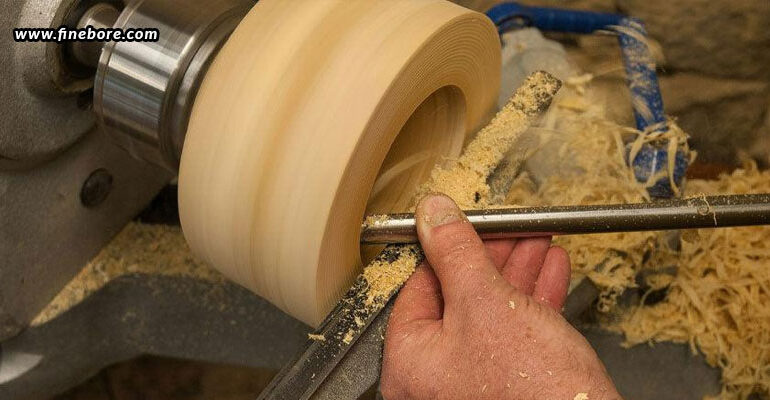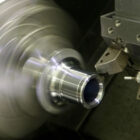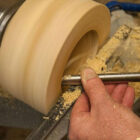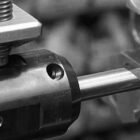Once primarily associated with cast iron and steel, boring bars have made their way into the realms of woodworking and advanced laboratories, establishing a significant presence in these fields. Originally designed for metal cutting, these tools have adapted and found new life in various applications. Today, woodworkers, aerospace engineers, and composite manufacturers are utilizing boring bars to achieve enhanced precision and innovation. This blog delves into the intriguing uses of boring bars in woodworking and composite machining, highlighting the tools, methods, benefits, and the future of non-metal boring processes.
Boring bars in woodworking
Woodworking has traditionally relied on drill bits, hole saws, and mortising machines for creating holes. However, when it comes to precision, finish, and control, particularly for deep or blind holes, boring bars present several advantages. These include tighter tolerances for joinery, smoother bore finishes, controlled chip removal, and the capability to adjust hole diameters with precision.
Common applications
- Furniture joinery: Ideal for producing perfectly round mortises or snug dowel holes.
- Musical instruments: Essential for shaping the exact internal cavities of wind instruments or drum shells.
- Wooden moulds and dies: Necessary when precise dimensions are critical for casting or pressing.
- Turned bowls and hollow forms: Woodturners utilize boring bars to hollow out vessels with exceptional control and smooth internal surfaces.
Challenges of boring in wood
Unlike metal, wood is not uniform. Its grain structure, moisture levels, and propensity to chip or splinter necessitate careful handling.
- Tool geometry must be tailored to slice rather than scrape.
- Feed rates should be slower and more intentional.
- Techniques to prevent tear-out, such as using backer blocks or climb cutting, are often required.
Specialized boring bars for wood
Certain manufacturers provide carbide-tipped boring bars designed specifically for woodwork.
- Swept-back cutting angles to minimize tear-out.
- Polished inserts that lower friction and enhance finish quality.
- Adjustable boring bars that allow for diameter adjustments during operation.
Boring bars in composite material machining
Composite materials, such as carbon fibre and fiberglass, have become vital in industries ranging from aerospace to automotive for their ability to produce lightweight yet durable components. However, machining these composites presents specific challenges, including abrasive fibres that quickly wear down tools, the risk of delamination during drilling or boring processes, and the generation of dust and hazardous particles that necessitate specialized containment measures. While routing and waterjet cutting are frequently employed, boring bars are particularly effective for achieving precise internal diameters in composite parts, especially when secondary operations or tight tolerances are needed.
Common applications
- Aerospace components: Enlarging pre-drilled holes in carbon fibre panels to accommodate bushings or fasteners.
- Automotive parts: Finishing bores in composite body structures or suspension components.
- Medical devices: Machining internal channels in fibre-reinforced plastics utilized in prosthetics or surgical instruments.
Challenges of composite boring
- Rapid tool wear due to the abrasive characteristics of composite materials.
- Generation of fine dust rather than chips, which poses health risks and can damage equipment.
- Challenges in managing debris without effective dust extraction systems.
- Risk of delamination caused by improper tool pressure or cutting methods.
- The necessity for specialized tool materials such as PCD, CBN, or coated carbides.
- Difficulty in maintaining sharp tool edges for clean cuts.
- Challenges in optimizing feed rates to reduce material separation.
- The need for vibration-assisted techniques to lower machining resistance.
Comparing metal, wood, and composite boring
Metal, wood, and composite materials each have distinct properties that affect boring processes.
- Metal: Metals are typically uniform, exhibiting moderate tool wear and stable feed rates, which result in the production of metal chips during machining. Common tooling materials include high-speed steel (HSS), carbide, and cubic boron nitride (CBN), with finishing objectives centred on achieving tight tolerances, particularly in aerospace, automotive, and die/mould industries.
- Wood: Wood features inconsistent grain patterns and moisture levels, which lead to reduced tool wear but necessitate adjustments in feed rates to prevent grain tear-out. This material generates sawdust or shavings and generally employs carbide or HSS tools, aiming for smooth, tear-free finishes in applications such as furniture making, musical instrument crafting, and various artisanal projects.
- Composites: Composites, being layered and abrasive, result in significant tool wear and produce fine dust instead of chips. They require slower feed rates to avoid delamination and utilize advanced tooling materials like polycrystalline diamond (PCD) and ceramics. The finishing goals for composites emphasize precision and structural integrity, making them suitable for industries such as aerospace, medical, and motorsport.
Boring bars have transcended their traditional roles in metalworking environments, finding applications in warm woodshops and cutting-edge composite laboratories. They offer enhanced accuracy, control, and a superior finish. Whether used in the depths of a handcrafted wooden piece or the sleek design of a carbon fibre drone, boring bars demonstrate their versatility. FineTech Toolings’ boring bars Coimbatore exemplify this advancement, designed for adaptability, longevity, and precision across various materials. As industries merge craftsmanship with technological innovation, FineTech Toolings’ solutions play a crucial role in shaping the intricate designs of tomorrow’s exceptional products.




